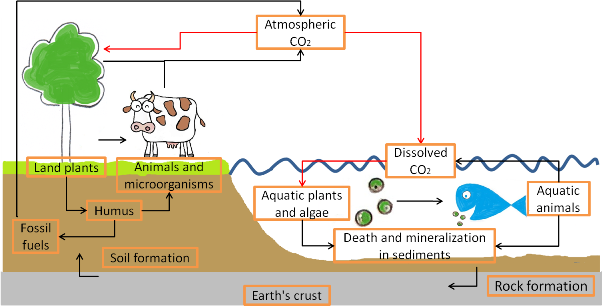Main menu
You are here
The Carbon Cycle
Globally, carbon is cycled through all Earth's major carbon reservoirs: the atmosphere, the land, the oceans and aquatic environments, sediments and rocks, biomass. This involves activity of both microorganisms (microalgae, bacteria, archaea, fungi, protozoa) and macroorganisms (plants, algae, animals, people).


More than 99.5% of total carbon on Earth is stored in the sediments and rocks of Earth's crust. Looking from our point of view (in human time scale) not much happens with this carbon. The most rapid means of global transfer of carbon is via the CO2 of the atmosphere. CO2 is removed from the atmosphere primarily by photosynthesis and returned by respiration. Land plants, algae and cyanobacteria (autotrophic organisms or producers) are converting inorganic carbon (atmospheric CO2, dissolved CO2) in organic carbon (biomass). This biomass is food for all other organisms.
Photosynthesis

Phototrophic organisms are converting solar energy to chemical energy with photosynthesis. The solar energy is accepted with pigments (chlorophyll, carotenoids, ...) and converted to energy stored in molecules (ATP, NADPH). As a side product the oxygen that we breathe is produced. The stored chemical energy is then used to convert inorganic CO2 to sugars.

(CH2O) represents sugars (polysaccharides), the main form in which the photosynthesized organic matter is stored in the cell.
These organisms also carry out respiration. Sugars and oxygen produced during photosynthesis are used and CO2 and water are released. In order for carbon cycle to sustain, the rate of photosynthesis must outrange the rate of respiration.
Carbon is returned to the atmosphere
Photosynthetically fixed carbon is eventually degraded by microorganisms to two major forms: methane (CH4) and carbon dioxide (CO2). Methane is produced in anoxic habitats and in oxic habitats it is converted to CO2. In this form, carbon is returned to the atmosphere and the cycle can be repeated.
In recent times, combustion of the fossil fuel added to the atmospheric CO2 reservoir and different methods have been proposed for mitigation and sequestration of CO2. These methods can be roughly divided to three groups: chemical reaction-based approaches, direct injection to the underground and biological approaches. Microalgae have been proposed as one of the biological approaches. Due to their faster growth in comparison with land plants, their efficiency of capturing the CO2 is expected to be 3- to 5-times better.
It should be noted that biological mitigation does not provide for permanent CO2 sequestration because carbon taken up during photosynthesis is actively cycled (as we see above). Instead, for example, growing microalgae on flue gasses conveys the CO2 into the cycle. Since microalgal biomass can be used to produce energy (biogas, biofuels) no additional CO2 is created.




